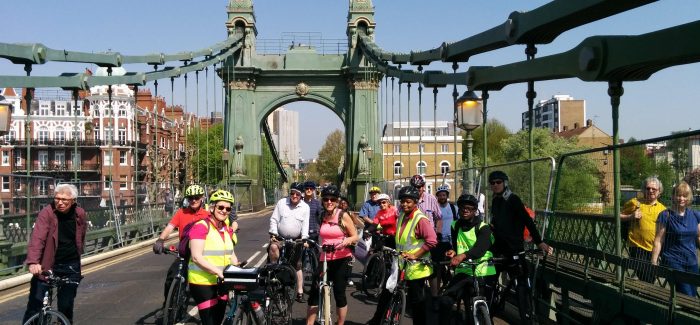
Southwark Cyclists Ride, April 22nd 2019 Organised by the Healthy Rides group and led by Werner. This is his report
Bazalgette’s legacy in London didn’t fit into Saturday’s ride (report here) so we had to add a second volume (and even that is not enough as there is far more, e.g. Abbey Mills and Crossness pumping stations and the Woolwich Ferry).
17 riders couldn’t resist the glorious London sunshine and set off from Burgess Park. Millions others could resist and London was unusually empty, it felt as if the only vehicles we saw before Blackfriars Road were two dust carts. That changed when we got Waterloo Bridge, downgraded again after its brief impersonation of a Garden Bridge. Lots of police on bridge, probably to prevent new outbreaks and they didn’t help us by parking their vans in the bike lane.
A 180 down to CS3 followed by a stop at the Bazalgette memorial to explain why it is the perfect location for it, he built the Embankment and put the sewer (and the tube) under it. Hat tip to Steve who led us to Villiers Gate in Victoria Embankment Gardens which marks the pre-Bazalgette boundary of the Thames. Thanks also to WH Smith who, as Westminster MP, saved the garden as a public space and stopped the Crown building office blocks on them.
We rode across Parliament Square at St Margaret’s (where the Bazalgettes got married) and across Gt George Street at the Institution of Civil Engineers before things got chaotic. On Saturday we noticed that we were unusually lucky, even the bike lane along Constitution Hill was tourist-free. Today regression to the mean struck: swarms of commercial bicycle tours (£27.95 for 3 hours) with very spontaneous riders and a Santander bike crashing in front of us. Lots and lots of tourists spread across the area around Buckingham Palace and filling the Constitution Hill cycle lane.
Peace and calm returned after we left Hyde Park for Belgravia, Pimlico, Chelsea and South Ken; the joy of bank holiday weekends in areas whose inhabitants have country residences to visit and leave the empty streets to us. Even better to feel the pain of a Lamborghini driver doing barely 30mph with an empty road in front of him, I am not sure whether empathy is the correct term to describe it.
The longest ever healthy ride so the offer of a resting place was appreciated, Brompton Cemetery is very cycle-friendly. No problems with their neighbour, Chelsea weren’t playing at home, so we continued to the next resting place, one with food and coffee. We took a generous break in Bishop’s Park in Fulham, esp. beautiful on an unseasonally sunny day in spring. Refreshed we reached the turning point of the ride. Hammersmith Bridge was the first of Bazalgette’s bridges we crossed today and we had arranged for it to be car free to allow us to take a group photo [actually, we did not really arrange this, see https://www.bbc.co.uk/news/uk-england-london-47891838].
Dropping down to the Thames Path kept us away from cars and near the river until we reached Putney and the second Bazalgette bridge. Putney Bridge is taking a lot of the Hammersmith Bridge traffic so was busy but the left turn at the end is easy and took us again into the Bishop of Fulham’s grounds. No home match at Craven Cottage today so no encounters with football fans. Another kind of away meeting was the one with National Cycle Route 4, more familiar to us when we ride it in Southwark. A Tideway sign near Lots Road showed that even Bazalgette’s sewers weren’t sized for eternity and the growth of London’s population (and sewage).
To complete the set of Embankments we rode along Chelsea Embankment and, after crossing Vauxhall Bridge, a bit of Albert Embankment. Not as enjoyable to ride as CS3 along Victoria Embankment; Albert should claim equality and ask for a segregated lane. Maybe as a 200th birthday present this year. At the junction with Black Prince Road we stopped and looked at a plaque which illustrates the reason for building the embankments: in Lambeth to prevent flooding and polluted Thames water getting into the water supply. It was the location of the third cholera case in 1848 recorded by John Snow in his 1855 paper: CASE 3 (onset Sept. 30, 1848; death Oct. 1, 1848). In the evening of the day on which the second case occurred in Horsleydown, a man was taken ill in Lower Fore Street, Lambeth, and died on the following morning. Now, the people in Lower Fore Street, Lambeth, obtained their water by dipping a pail into the Thames, there being no other supply in the street.
After 4h30′ and 38km we got back to Burgess Park having shown that we can handle longer distances than we had covered previously. Thanks to Jane for backmarking and keeping the field together. Route here: http://taffimai.w2.org.uk/healthy-rides/Bazalgette-40-20190422.html
More information about Healthy Rides at Healthy Rides Home Page

 LONDON CYCLING FESTIVAL
LONDON CYCLING FESTIVAL
Submit a Comment